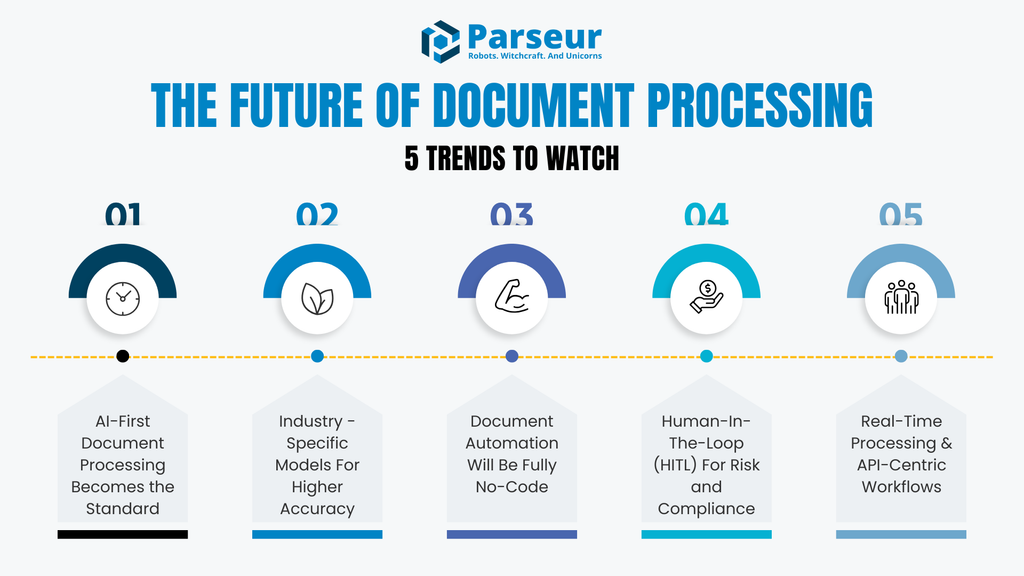Key Takeaways
- AI is transforming document automation: Businesses are shifting from rule-based OCR to intelligent document processing (IDP), which understands the structure, context, and variability across documents.
- No-code solutions are democratizing automation: Platforms like Parseur allow non-technical teams to build and manage parsing workflows, accelerating time to value without engineering dependency.
- Domain-specific AI models enhance accuracy: Tailored parsing engines for industries such as logistics, healthcare, and finance increase precision and reduce error-prone exceptions.
- Human-in-the-loop (HITL) is becoming increasingly critical: As AI takes over high-volume tasks, HITL workflows ensure oversight, validation, and auditability, particularly in compliance-heavy sectors.
- Real-time ecosystems are the next frontier: Document processing is no longer a siloed function. APIs, connectors (such as Zapier, Make, and Power Automate), and real-time triggers are essential for scalability and system-wide automation.
Document Processing Is Entering A New Era
As we move into 2026 and beyond, organizations are no longer asking “How do we automate?” They are asking, “How do we scale automation intelligently, securely, and in real time?”
As organizations accelerate their digital transformation journeys, the need for faster, smarter, and more scalable document management solutions is reaching a critical mass. Traditional OCR-based workflows, once considered innovative, are rapidly being replaced by intelligent document processing (IDP) solutions that leverage artificial intelligence, machine learning, and no-code platforms to deliver end-to-end automation.
According to recent forecasts by MetaTech Research and Scoop Market Insights, the global document processing market is expected to exceed $60 billion by 2030, driven by demand for real-time data extraction, cross-platform interoperability, and AI-powered decision-making.
In this article, we explore five key trends shaping the future of document processing, from the evolution of OCR into context-aware IDP to the rise of no-code interfaces and real-time API ecosystems. Whether you're in finance, logistics, insurance, or SaaS, staying ahead of these trends can help your organization unlock greater efficiency, compliance, and scalability.
Check out our Document Processing guide to learn how to optimize, automate, and future-proof your document workflows currently.

Trend #1: AI-First Document Processing Becomes The Standard
Document automation is evolving beyond rigid templates and fixed rules. Current leading solutions are built AI-first, designed to extract data intelligently with greater speed, accuracy, and flexibility.
Modern tools now use computer vision, natural language processing (NLP), and machine learning to process a wide range of document types. These technologies can identify document structures, detect relevant data fields, and flag inconsistencies within documents. Unlike static rule-based systems, AI-powered platforms continuously improve as they learn from corrections and new inputs.
One of the most impactful developments is the rise of self-learning document models. These models get smarter over time, adapting to layout variations and reducing the need for constant manual updates.
The global intelligent document processing (IDP) market size was valued at USD 2.56 billion in 2024 and is projected to reach USD 54.54 billion by 2035, growing at a compound annual growth rate (CAGR) of approximately 32.06% between 2025 and 2035, as reported by MetaTech Insights.
Why it matters
AI-first document management tools are now the standard. Organizations relying solely on rule-based approaches may struggle to keep pace with the increasing variety and volume of documents. AI-driven platforms are better equipped to scale, adapt, and deliver long-term value.
Trend #2: Industry-Specific Models For Higher Accuracy
As businesses handle increasingly complex and regulated documents, the need for tailored document handling is growing. One-size-fits-all tools are becoming outdated. The future lies in industry-specific models that deliver higher accuracy, compliance, and operational efficiency.
Sectors such as finance, healthcare, logistics, and legal require precision and accuracy. From tax forms and insurance claims to bills of lading and legal contracts, these documents often contain unique layouts, terminology, and regulatory requirements. Generic parsing engines struggle to interpret this variety without significant customization.
Next-generation intelligent document processing (IDP) tools are addressing this by embedding vertical-specific logic. These platforms come with a built-in understanding of field types, formats, and context that are common within a specific industry. For instance, they can recognize healthcare claim codes, legal clauses, or invoice line items without additional training.
PMarket Research found that in healthcare, automated processing of decades‑old patient records delivers 30–40 percent lower accuracy compared to structured invoices, highlighting the limitations of generic systems when applied to complex vertical documents
Why it matters
Selecting a tool that supports industry-specific accuracy can significantly reduce error rates, compliance risks, and the need for manual review. This ensures smoother workflows and greater ROI on automation efforts.
Trend #3: Document Automation Will Be Fully No-Code
The future of document handling is not just intelligent, it is accessible. Instead of relying on developers, business users can now build, adjust, and scale their document workflows.
Modern platforms offer intuitive drag-and-drop interfaces, AI-powered field detection, and seamless integrations with tools like Google Sheets, Excel, CRMs, and automation platforms such as Zapier and Make. This means finance, HR, operations, and logistics teams can directly manage their parsing flows, reducing bottlenecks and boosting agility.
According to Fortune Business Insights, it is projected that 75% of all new applications will be developed using low-code by 2026, with 80% of operators being non-IT developers.
Why it matters
Document processing solutions democratize document automation, making it easier and faster for businesses to adopt and adapt workflows. This improves efficiency, accelerates implementation, and enables continuous improvement without technical roadblocks.
Trend #4: Human-In-The-Loop (HITL) For Risk And Compliance
As document automation becomes more advanced, regulatory and compliance requirements are pushing businesses to maintain oversight and accountability. Human-in-the-Loop (HITL) systems are emerging as a critical component of intelligent document processing, offering a balance between automation and human review.
For industries bound by regulations such as GDPR, HIPAA, or SOX, relying solely on AI is insufficient. HITL workflows enable teams to review flagged extractions manually, validate fields below confidence thresholds, and approve sensitive data before it is processed further.
Leading tools are now embedding review dashboards and automated alert systems to notify users via Slack, email, or internal systems when human validation is needed. Parseur, for example, allows fallback mechanisms that send alerts or route documents for manual export if extraction accuracy falls below a set threshold.
These safeguards help businesses maintain trust, ensure compliance, and reduce the risk of costly errors or violations.
Studies from Infrrd show that HITL systems can reduce document processing costs by up to 70 % while significantly lowering error rates.
Why it matters
HITL functionality adds a vital layer of accountability, especially in high-stakes industries. As automation expands, having human review built into the workflow will become a non-negotiable feature for future-ready platforms.
Pro tip
Look for solutions that offer audit logs, version history, and validation controls to support compliance and ensure transparency.
Trend #5: Real-Time Processing & API-Centric Workflows
As digital workflows become more interconnected, businesses can no longer afford to treat document processing as a delayed, asynchronous task. Real-time document automation is emerging as the new standard, particularly in high-volume, time-sensitive industries such as logistics, finance, insurance, and e-commerce.
Whether it's processing invoices for same-day payment, extracting bill of lading details for immediate shipment tracking, or onboarding customers with instant KYC validation, organizations are moving toward real-time document ingestion, parsing, and delivery. The goal is to minimize latency, reduce manual intervention, and enable faster business decisions.
A study from PR Newswire of 1,200 companies across four key industries found that 80 % of businesses increased revenue by leveraging real-time data insights.
Why it matters
Real-time document processing reduces bottlenecks, improves service level agreement (SLA) compliance, and enhances the customer experience. It enables scalable, event-driven architectures that respond to inputs instantly.
The Next Phase: Intelligent Document Ecosystems
Document processing is no longer just about extracting data. It is becoming a core part of business intelligence. As organizations mature their automation efforts, they are starting to build interconnected ecosystems that go beyond parsing.
Future-ready tools will not only pull information from invoices or forms. They will also automatically classify documents, validate extracted data, generate insights, and trigger actions, all within a single platform. These systems will serve as intelligent hubs that understand documents in context and support more informed decision-making across departments.
Scoop Market stated that the global intelligent document processing market is projected to grow from USD 4.38 billion in 2026 and continue its expansion into the early 2030s.
Why it matters
An intelligent ecosystem empowers teams to automate entire processes, rather than just individual tasks. It reduces reliance on disconnected tools and builds a stronger foundation for scalable, smarter operations.
The Future of Document Processing Is Intelligent, Integrated, and Instant
The document processing landscape is evolving rapidly, driven by advances in artificial intelligence, no-code automation, and real-time data delivery. As these five trends reveal, businesses that continue to rely solely on traditional OCR or rule-based systems risk falling behind.
Modern intelligent document processing (IDP) platforms go far beyond text recognition. They understand context, adapt to new document layouts, integrate across your tech stack, and empower non-technical teams to build workflows without writing a single line of code.
Whether you're looking to improve operational efficiency, reduce compliance risk, or scale your document workflows globally, embracing these trends can help future-proof your business.
Founders’ Insight
Data is like currency; the faster it moves, the more value it creates. Over the past few years, AI-powered document processing has revolutionized how companies unlock that value. At Parseur, we’ve witnessed firsthand how automating the extraction of data from documents can transform workflows in just a few clicks. As this technology evolves, it will further accelerate data flow, unleashing exponential productivity gains across industries. — Sylvestre Dupont, Co-Founder, Parseur
Want to explore how document automation can work for your organization?
Visit our Document Processing Hub to learn more or start your free trial with Parseur.
Frequently Asked Questions
To help you navigate the innovative landscape of document automation, we've compiled answers to some of the most commonly asked questions. These insights will help you make more informed decisions about automation.
-
What is the future of OCR and document processing?
-
The future of OCR (Optical Character Recognition) lies in intelligent document processing (IDP). While traditional OCR extracts text, IDP combines OCR with AI, machine learning, and natural language processing to understand, categorize, and extract structured data from unstructured documents. Businesses are moving toward platforms that offer greater accuracy, flexibility, and scalability through real-time and API-driven workflows.
-
How will AI change document automation?
-
AI is shifting document automation from rule-based workflows to intelligent systems that learn and adapt over time. Instead of relying on fixed templates, AI-powered tools can recognize patterns, detect anomalies, and continuously improve data extraction. This results in faster processing, fewer manual interventions, and greater reliability in handling complex document types.
-
How do I choose a future-ready document processing tool?
-
An automated and intelligent document processing tool should offer more than just data extraction. Look for features like AI-enhanced accuracy, support for industry-specific documents, no-code configuration, real-time API delivery, and compliance-friendly workflows. Document processing tools like Parseur stand out by combining intelligent automation with ease of use and reliability.
Last updated on






